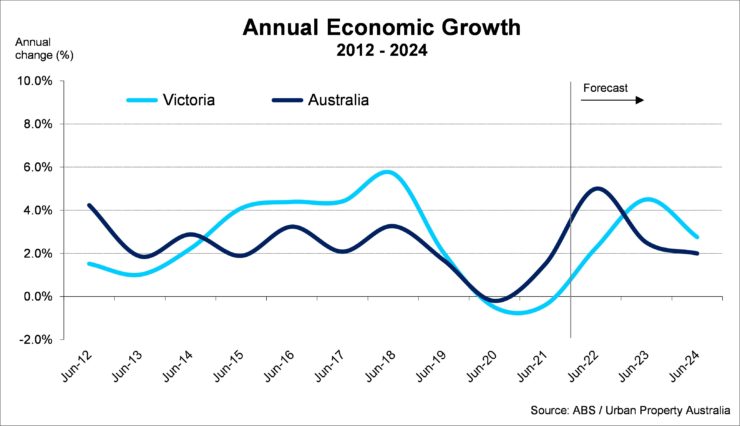Q1 2022 – Victorian Economic Overview
April 22nd 2022 | , Urban Property Australia
After the easing of necessary public health restrictions, the Victorian economy continues to recover strongly. By June 2021, Victorian state final demand had recovered to be above pre-pandemic levels. Amid the global coronavirus pandemic, which led to a significant global economic downturn, real gross state product (GSP) fell by 0.4% in 2020/21. Looking ahead, the Victorian economy is forecast to grow by 2.25% in 2021/22, before rising to 4.50% in 2022/23.

The outbreak of the Delta variant of COVID-19 caused a setback to this strong recovery, but the economic recovery is expected to resume quickly now that most domestic restrictions have been eased.
Now that vaccination rates have risen and most domestic restrictions have been eased, economic activity and employment are expected to pick up quickly.
The Government has allocated more than $13 billion in business support since the COVID-19 pandemic began and implemented programs to support Victorian households. This strong support during recent restrictions meant that, in aggregate, businesses and households were in a robust position as the economy reopened. The recovery will also be supported by low interest rates and strong demand for workers.
With the State government, having targeted to create 400,000 jobs by 2025 from 2021, such was the strength of the recovery of Victoria’s economic activity and employment, employment had risen by 288,000 since its trough in September 2020, while the unemployment rate fell to a record low of 4.1% and the workforce participation rate was at a record high.
The labour market in Victoria’s regions, which have in general been less affected by necessary public health restrictions than metropolitan Melbourne, has been considerably stronger than that of Melbourne.
Employment growth is expected to reach 2.5% in 2021/22 with the unemployment rate is expected to average 4.5% in 2021/22.
Household consumption is expected to increase in 2021/22. Over the coming year, spending is expected to be supported by improvement in the labour market, high asset prices and elevated consumer confidence. Household incomes have also been supported by government payments, and households have further added to high levels of savings. Consumers are expected to draw down on some of these savings as opportunities for spending that were constrained by public health restrictions become available again.
Over the longer term, the current period of low population growth will have an enduring effect on the size of the Victorian economy. Population growth, led by high levels of net overseas migration, had been an important driver of Victorian economic growth in recent years. Since March 2020, Victoria recorded a net outflow of overseas migration, and net migration is expected to remain subdued for some time.
Victoria’s population is forecast to grow by 0.2% in 2021/22. As migrant flows gradually increase with the relaxing of border restrictions, including the return of international students, population growth is expected to reach 1.7% by 2023/24.
Copyright © 2022 by Urban Property Australia All rights reserved. No part of this publication may be reproduced in any form, by microfilm, xerography, electronically or otherwise, or incorporated into any information retrieval system, without the written permission of the copyright owner.



